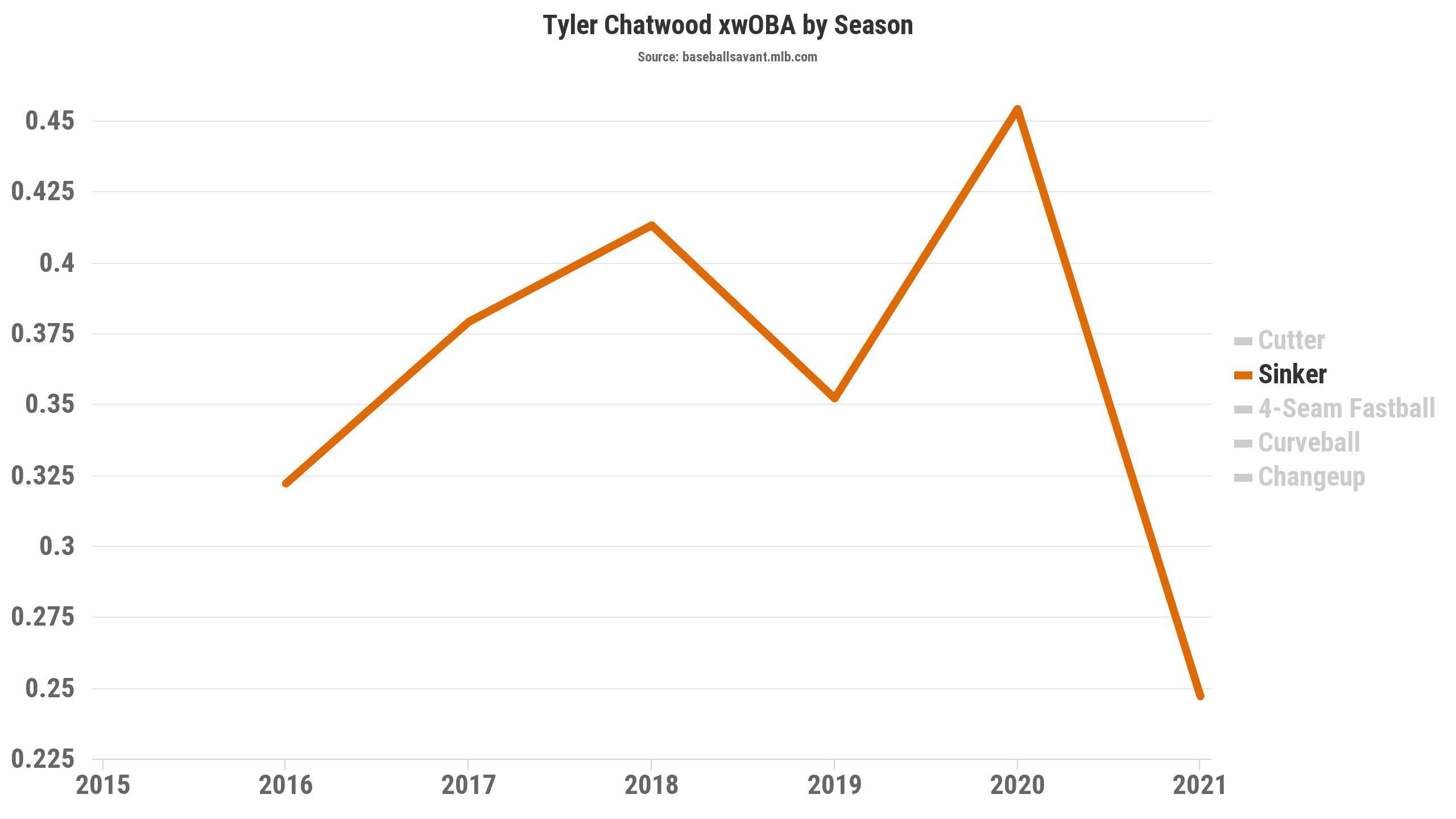The strikeout rate leaderboard for relievers this season includes a handful of familiar faces. Aroldis Chapman leads the pack. James Karinchak, Josh Hader, and Craig Kimbrel are all in the top 10. One of the most surprising names on the leaderboard is Tyler Chatwood. Yes, that Tyler Chatwood, he of the career 16.8% strikeout rate.
The former starter signed a one-year deal with the Toronto Blue Jays for the 2021 campaign, and the team shifted him to the bullpen full-time. The move has paid dividends, as the veteran has been one of the best relievers in the sport to begin the season. He is punching out hitters at a superb 38.2% rate, and he has allowed just one earned run in 14 2/3 innings for a 0.61 ERA. ERA estimators confirm that Chatwood’s early dominance has been legitimate. He has a 1.28 FIP, 1.79 xERA, 2.05 SIERA, and 3.18 DRA. On top of that, the former Rockie and Cub is posting elite marks in many key Statcast metrics.

A mediocre starter finding success after moving to relief is not a unique story. We’ve seen this movie before. Chatwood, however, is not following the usual script. When we think of dominant relievers with exceptional strikeout totals, we think of blazing four-seam fastballs thrown up in the zone and wipeout breaking balls.
Enter Chatwood. He throws a curveball, but is using it sparingly, just 4% of the time. Four-seam fastballs account for just 5% of his pitches. Instead, his primary pitch is now a fantastic cutter. For the first time in his career, Chatwood is throwing more cutters than he is any other pitch. He is pairing it with a sinker that he throws 42% of the time. He will also mix in a changeup on occasion, but Chatwood had largely pushed the secondaries he used as a starter to the backburner while letting his two fastballs do the heavy lifting.

The Emergence of the Cutter
This is not a new pitch for Chatwood; he developed a swing-and-miss cutter that he used often last year with the Cubs. The difference is that he is now using it even more. It’s generating whiffs on 46.3% of swings against it while holding opponents to a miniscule .128 wOBA and .166 xwOBA.
Chatwood uses his cutter as his main pitch against right-handed batters. He’ll throw it higher in the zone on the outside corner when he needs a called strike and down and off the plate when looking for a swing and miss. Here he is starting Jean Segura off with a high cutter and finishing him off with one that is low and out.
Bucking Conventional Sinker Wisdom
On average, pitchers will throw far more sinkers to same-handed batters. Sinkers and two-seam fastballs have accounted for 7% of right-on-right pitches across the league versus just 4.4% of right-on-left pitches. More often than not, pitchers focus on throwing these sinking fastballs down-and-in to induce weak contact.
Chatwood is doing exactly the opposite. He has turned to his sinker as his go-to pitch against left-handed batters (60% usage), and he’s specifically focusing on starting them on the outside corner so that they tail off the plate. He will sometimes use the sinker to induce ground balls, but often times, he throws it with the intent of blowing hitters away. Below are a few examples of Chatwood getting empty swings two-seamers at or above the belt on the outer half of zone.
The new approach has helped Chatwood erase his previously drastic platoon splits. Entering this season, lefties posted a career .810 OPS against him. This season, that figure is down to .343. So far, the veteran has been even stingier against lefties than he has against right-handed hitters. Speaking of righties, Chatwood continues to use his sinker against them, too. Just as he has against southpaws, he has shifted his approach to include more high sinkers to induce whiffs.
Why the change? Chatwood and the Blue Jays realized that his sinker is not like a traditional sinker, and therefore it shouldn’t be used like one. A good sinker has a low spin rate; this allows gravity to have a greater impact on the baseball and give it the sinking action as it approaches the plate that causes hitters to roll over it. Since the start of the 2019 season, Chatwood’s sinker has averaged nearly 2500 revolutions per minute, making it one of the highest spinning sinkers in the majors. The right-hander doesn’t have a bowling ball sinker; if anything, he has a “riding sinker.” The conventional wisdom of pounding sinkers down in the zone was actually bad advice for Chatwood, so he has started to ditch the traditional logic. Observe the noticeable change in Chatwood’s sinker location from 2020 to 2021:

So far, the change is working splendidly. For the first time in his career, Chatwood’s sinker is looking like a clear plus pitch.

In an age where relievers pile up impressive strikeout totals with power four-seam fastballs and wipeout breaking balls, Tyler Chatwood is breaking the mold. The starter-turned-reliever is using a magnificent cutter and unique sinker to post strikeout and run prevention numbers that rival the game’s best late-inning arms. The cutter is legitimate; the question is if the sinker can continue to induce whiffs moving forward. So far, Chatwood has used an unorthodox strategy to turn himself into a late-inning force in Toronto’s bullpen. He’s worth keeping an eye on as the season progresses.
Photo by Russell Lansford/Icon Sportswire | Adapted by Doug Carlin (@Bdougals on Twitter)


How can max exit velocity be lower than average exit velocity?